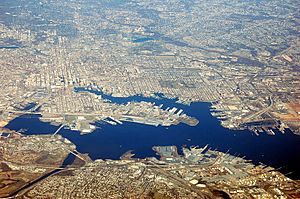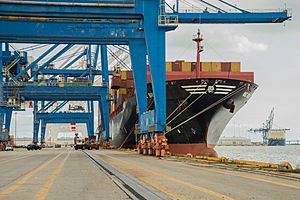Port of Baltimore facts for kids
Quick facts for kids Port of Baltimore |
|
|---|---|
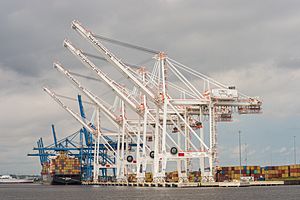 |
|
| Details | |
| Owned by | Maryland Port Administration |
| Draft depth | 50 feet |
| Air draft | 185 feet, restricted by Francis Scott Key Bridge (built 1975–1977) |
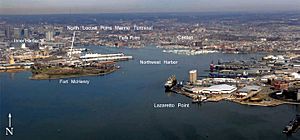
The Helen Delich Bentley Port of Baltimore is a busy shipping port in Baltimore, Maryland. It sits along the Patapsco River and connects to the Chesapeake Bay. This port is one of the biggest in the United States for special cargo. It handles "roll-on/roll-off" ships, which carry vehicles and large equipment. It also has facilities for passengers.
The Maryland Port Administration (MPA) operates the port. This is a part of the Maryland Department of Transportation. In 2006, the port celebrated its 300th birthday. It was renamed to honor Helen Delich Bentley. She was a former U.S. Representative (Congresswoman) from Baltimore. Before that, she was a reporter who wrote about ships and the sea.
Contents
History of the Port of Baltimore
Early Explorations and Founding
In 1608, Captain John Smith explored the Chesapeake Bay. He traveled 170 miles from Jamestown. He was the first European to explore the Patapsco River. Native Algonquian peoples had already named the river.
In 1702, land grants were combined by James Carroll. He named the area Whetstone Point. This was because the land looked like a sharpening stone. Today, this area is called Locust Point.
The port was officially started here in 1706. The colonial government of Maryland made it an official "Port of Entry." This meant ships could bring tobacco here to trade with England. In 1729–1730, Baltimore Town was founded nearby. It was located at "The Basin," which is now known as the Inner Harbor.
Defending the Port and Shipbuilding
During the American Revolutionary War in 1776, local people built defenses. These were called Fort Whetstone. Later, in 1798, these defenses were replaced. Fort McHenry was built and made stronger with brick and stone. It was shaped like a star. The U.S. Army and its Corps of Engineers built this fort.
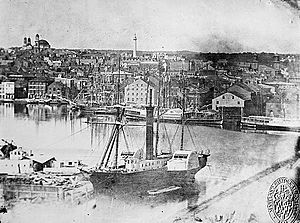
Fells Point was first named Long Island Point in 1670. It became the main shipbuilding center in the colony. Many shipyards built famous "Baltimore clipper" schooners. These fast ships were used by privateers, who attacked enemy merchant ships.
This activity led to the British attack in September 1814. This was during the War of 1812, known as the Battle of Baltimore. The British bombarded Fort McHenry. They also attacked by land at the Battle of North Point.
Fells Point became part of Baltimore Town in 1773. The first U.S. Navy warship, USS Virginia, was ordered from Fells Point in 1775. Other famous ships like the USS Constellation and USS Enterprise were also built here. From 1784 to 1821, over 800 ships were built in Fells Point.
Growth and Industry
After Baltimore was founded, the waterfront grew. Drydocks (for repairing ships), warehouses, and shops selling ship supplies were built. Industries like mills also grew near the wharves.
Further southeast, in what is now Canton, more industry developed. John O'Donnell's land became home to workers and factories. This included the Canton Iron Works.
In 1828, the Baltimore and Ohio Railroad (B&O) began laying tracks. By 1845, the railroad reached Locust Point. The arrival of railroads made the port a major transfer point. Goods could move easily between inland areas and the rest of the world.
By the 1840s, the Baltimore Steam Packet Company offered overnight steamship service. After the Civil War, special coffee ships were designed here. They were used for trade with Brazil. Other industries in Canton included copper smelting and oil refineries. By the late 1800s, European shipping lines had terminals for immigrants. People from Britain, Ireland, Germany, and Poland arrived here.
Maintaining Harbor Channels
Keeping the harbor channels clear for ships started early. Dredging (removing mud from the bottom) began in 1783. In 1790, the state government started regular dredging. They used a "mud machine" pulled by horses.
In 1825, Senator Sam Smith asked the U.S. Congress for money. He wanted federal funds for dredging. Congress agreed and federal dredging began in 1830. This first project finished in 1838.
In the 1850s, a second dredging project began. Captain Henry Brewerton oversaw this work. He dug a straight channel from Sparrows Point. It went out to the mouth of the Patapsco River. This channel is known today as the Brewerton Channel. It is still the main path into the harbor.
In 1865, Major William P. Craighill took over. He found that the Brewerton Channel was getting shallow. He dug a new channel that connected to the old one. This new channel is called the Craighill Channel. Both the Brewerton and Craighill Channels are still used today.
Lighthouses were also built to guide ships. In 1822, the North Point Range Lights were lit. They marked a path into the Patapsco. As new channels were dug, more lights were added. Today, all these lights are automated. The Craighill Channel Lower Range Rear Light is the tallest lighthouse in Maryland.
In 2006, Governor Bob Ehrlich officially named the port after Helen Delich Bentley. This happened during the port's 300th anniversary.
Current Port Operations
The Port of Baltimore is very active today. It has large facilities for "roll-on/roll-off" (ro-ro) ships. These ships carry vehicles and heavy equipment. The port also handles bulk cargo, especially steel. About 700,000 vehicles pass through the port each year. In 2004, most Mercedes-Benz cars imported into the U.S. came through Baltimore.
In 2012, the port handled 36.7 million tons of foreign goods. These goods were worth $53.9 billion. The Port of Baltimore ranked 11th among 36 U.S. ports for foreign tonnage. It was 9th in the dollar value of cargo handled.
By the third quarter of 2017, the port saw a 15% increase in general cargo. Since 2014, the Port of Baltimore has grown quickly. It is the fourth fastest-growing port in North America. It ranks 8th among U.S. ports for total tonnage. It is 7th in the dollar value of cargo.
Port Facilities and Terminals
The Port of Baltimore has five main terminal areas. These are located in a special industrial zone.
- Dundalk Marine Terminal: This terminal handles many types of cargo. It includes containers, wood pulp, and vehicles. It has 13 berths (places where ships dock). The water depth varies from 34 to 50 feet. This facility has 790,000 square feet of indoor storage. It also has large outdoor areas for containers, break-bulk cargo, and vehicles.
- Seagirt Marine Terminal: This terminal focuses on containers. It has 4 berths. The water depth is 45 to 50 feet. The facility has 4 super post-Panamax cranes. These are huge cranes that can unload very large ships. It also has 7 post-Panamax cranes and 22 rubber-tired gantry cranes. There are 134 acres of outdoor storage for containers.
- Fairfield Marine Automobile Terminal: This terminal handles "roll-on/roll-off" cargo and vehicles. It has 2 berths. The water depth is 23 to 49 feet. The facility includes 61 acres of buildings for processing cars.
- North Locust Point: This terminal handles wood pulp, lumber, steel, and paper. It has 5 piers. The water depth is 34 feet. It has 180,000 square feet of indoor storage. There are also 19 acres of open storage.
- South Locust Point: This terminal handles forest products. It has 3 general cargo berths. The water depth is 36 feet. This facility has 935,000 square feet of indoor storage.
Port of Baltimore in Popular Culture
The Port of Baltimore has appeared in several movies and TV shows.
- In the 1996 action movie Eraser, the final battle takes place at the "Baltimore Docks."
- The 2002 thriller movie The Sum of All Fears also featured the Port of Baltimore.
- The second season of the HBO series The Wire is set around the activities at the Port of Baltimore.
Images for kids


